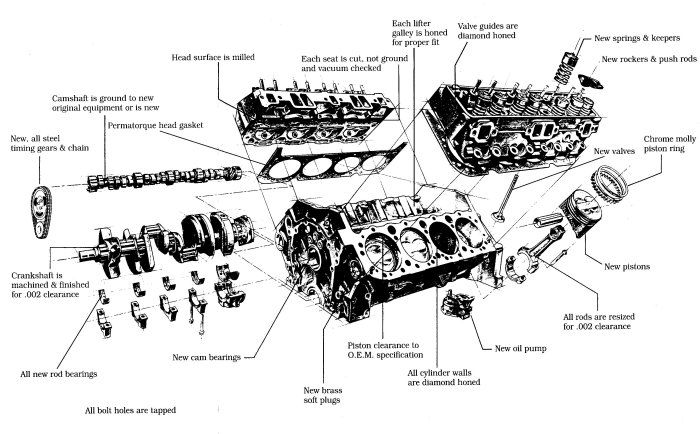Small Block Chevy 350 Engine Parts Diagram

The Small Block Chevy 350, a cornerstone of American automotive engineering, is renowned for its reliability, performance, and sheer ubiquity. Understanding its components is crucial for anyone from a casual enthusiast to a seasoned mechanic. This article provides a detailed overview of the 350's key parts, focusing on their function and location within the engine.
The Foundation: Block and Rotating Assembly
At the heart of the 350 lies the engine block itself, typically cast iron, though aluminum aftermarket options are available. The block houses the cylinders, where combustion occurs. Crucial block features include:
- Cylinder bores: Precisely machined holes where the pistons travel.
- Water jackets: Passages around the cylinders for coolant circulation, vital for temperature regulation.
- Oil galleries: Channels that distribute lubricating oil throughout the engine.
- Main bearing bores: Seats for the main bearings, which support the crankshaft.
The rotating assembly, responsible for converting combustion energy into rotational motion, comprises the following:
- Crankshaft: The central component that transforms the linear motion of the pistons into rotational force. It's supported by main bearings.
- Connecting rods: Connect the pistons to the crankshaft, transferring force. They utilize rod bearings at both the piston and crankshaft ends.
- Pistons: Move up and down within the cylinders, compressing the air-fuel mixture and receiving the force of combustion. Piston rings seal the piston against the cylinder wall, preventing blow-by.
- Harmonic balancer (Damper): Attached to the front of the crankshaft, it dampens torsional vibrations to prevent engine damage.
- Flywheel/Flexplate: Attached to the rear of the crankshaft, it provides inertia for smooth engine operation. Flexplates are used with automatic transmissions, while flywheels are used with manual transmissions.
Top End: Cylinder Heads and Valvetrain
The cylinder heads sit atop the block, sealing the cylinders and housing the valves, valve springs, and combustion chambers. Important features include:
- Intake ports: Passages that allow the air-fuel mixture to enter the combustion chamber.
- Exhaust ports: Passages that allow exhaust gases to exit the combustion chamber.
- Combustion chambers: The space above the piston where the air-fuel mixture ignites.
- Valve seats: Precision-machined surfaces where the valves seal against the cylinder head.
The valvetrain controls the timing and duration of valve opening and closing. Key components include:
- Camshaft: A rotating shaft with lobes that actuate the valves. It's driven by a timing chain or gear from the crankshaft.
- Lifters (Tappets): Transfer the motion of the camshaft lobes to the pushrods. They can be hydraulic or solid.
- Pushrods: Transfer the motion from the lifters to the rocker arms.
- Rocker arms: Pivot to open and close the valves.
- Valves: Open and close the intake and exhaust ports, controlling the flow of gases into and out of the combustion chamber.
- Valve springs: Return the valves to their closed position.
- Retainers and keepers: Secure the valve springs to the valves.
Fuel and Ignition Systems
The fuel system delivers the air-fuel mixture to the combustion chamber. Depending on the year and configuration of the 350, this could be:
- Carburetor: Mixes air and fuel mechanically. Key components include the fuel bowl, jets, and throttle plates.
- Fuel Injection (TBI, EFI): Electronically controls fuel delivery. Components include fuel injectors, fuel rails, and a fuel pressure regulator.
The ignition system ignites the air-fuel mixture. Key components include:
- Distributor: Distributes high-voltage electricity to the spark plugs in the correct firing order.
- Ignition coil: Steps up the voltage from the battery to a high voltage sufficient to create a spark.
- Spark plugs: Ignite the air-fuel mixture in the cylinders.
- Ignition control module (ICM): Controls the timing and duration of the spark (often integrated into the distributor).
Other Essential Components
- Oil pump: Circulates oil throughout the engine to lubricate moving parts.
- Water pump: Circulates coolant through the engine and radiator to regulate temperature.
- Intake manifold: Distributes the air-fuel mixture to the cylinders.
- Exhaust manifolds/Headers: Collect exhaust gases from the cylinder heads. Headers generally offer improved performance over stock manifolds.
- Timing cover: Covers the timing chain or gears.
- Valve covers: Cover the valvetrain components.
- Oil pan: Holds the engine oil.
This overview provides a solid foundation for understanding the components of the Small Block Chevy 350. Familiarity with these parts will enable you to better diagnose problems, perform maintenance, and even undertake performance upgrades. Remember to always consult a repair manual and follow safety precautions when working on any engine.
